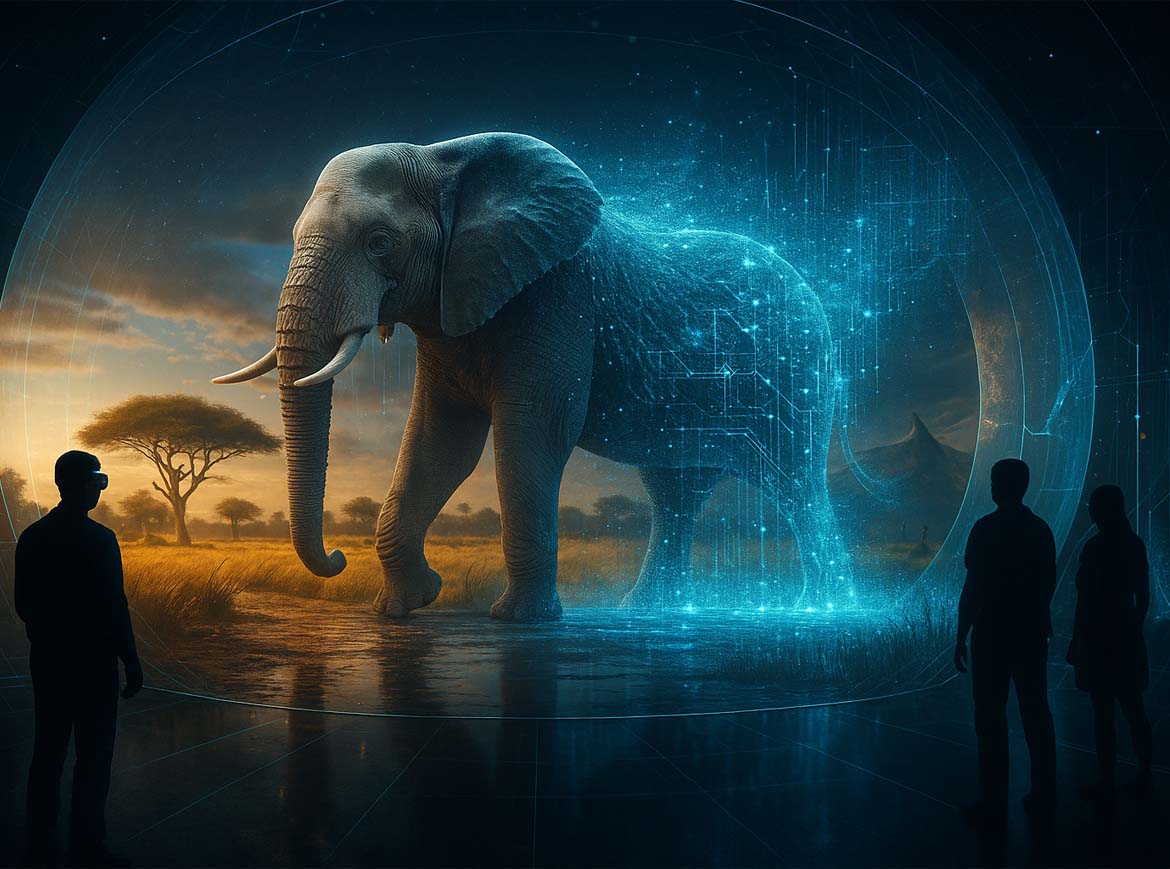Image source: © [Visualization Ulrich Buckenlei / XR Stager 2025]
Holographic zoos are more than a technological experiment. They combine AI, Mixed Reality, and real-time 3D generation to create immersive wildlife experiences—without removing animals from their natural habitats. Visitors can realistically experience, learn about, and interact with animals, while animal welfare and sustainability remain a top priority.
Image: XR Stager / AI-generated visual
The Vision Behind Holo-Zoos
The concept of a holographic zoo is not only futuristic but also ethical and educational. Using Mixed Reality and Artificial Intelligence, animals are projected into the space in photorealistic detail—with accurate behavior, natural movement, and interactive learning elements. The aim is to create a place where people can develop a deep understanding of wildlife without disturbing its habitat.
Technological Foundation of Holo-Zoos
Bringing a holographic zoo to life relies on the interplay of cutting-edge technologies. High-resolution 3D scans and volumetric video capture every detail of an animal—from the texture of its fur to subtle muscle movements. Artificial intelligence interprets and simulates behavioral patterns, while Mixed Reality systems project them into the physical space. The result is an immersive, realistic encounter that actively engages visitors.
Benefits for Conservation and Research
Holo-zoos open new possibilities to present endangered species without removing them from their natural environment. Researchers can collect realistic behavioral data, educational institutions can convey knowledge interactively, and visitors can experience animals in ways that are both fascinating and respectful. This not only raises awareness but also contributes to the protection of endangered species.
- AI-powered animal models → Capturing and simulating movements in real time.
- Mixed Reality interaction → Visitors see and experience animals in 3D environments.
- Sustainable education → No transport, no captivity, full knowledge transfer.
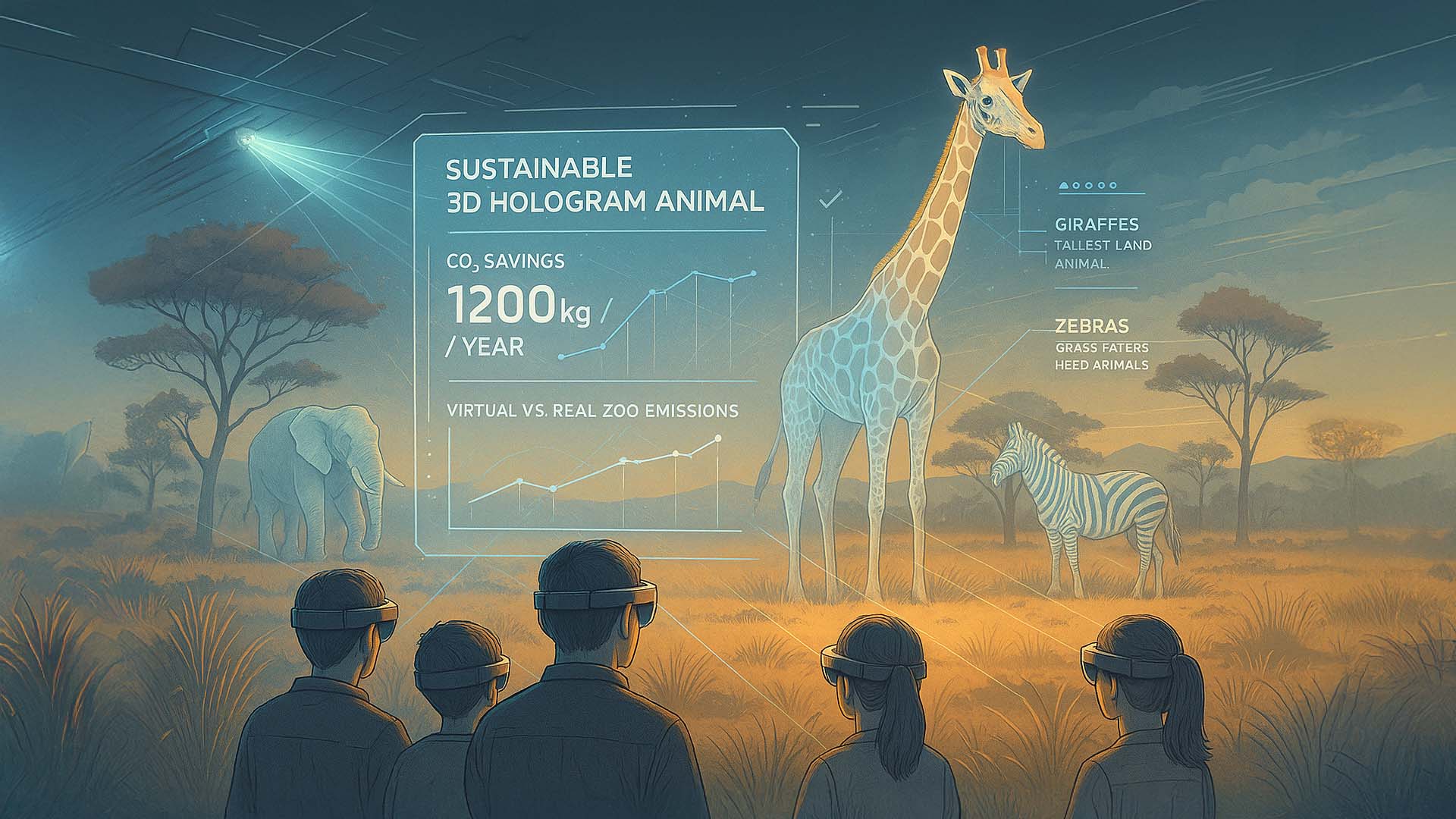
A Holo-Zoo experience begins with an immersive introduction.
This new approach combines education, entertainment, and sustainability in a way that traditional zoos or documentaries cannot match. It is a leap into the future of animal experiences.
Economic and Societal Perspectives
In addition to its educational aspect, holo-zoos offer potential for tourism and economic development. Museums, amusement parks, or urban experience centers can use this technology to create entirely new attractions that work independently of animal husbandry and location. At the same time, such installations encourage public debate on ethics, sustainability, and the responsible use of modern technologies.
Mixed Reality Wildlife Experience
A highlight of this new world of experiences is the Mixed Reality Wildlife Experience. Here, visitors enter a virtual ecosystem where animals do not just appear statically but act in their natural behavior—feeding, hunting, playing, or resting. Thanks to AI, these behavioral patterns are individual and unpredictable.
Immersion on a New Level
The Mixed Reality Wildlife Experience goes far beyond traditional animal presentations. Visitors move freely through a digitally enhanced landscape where animals respond to their presence. Every encounter is unique, as artificial intelligence adjusts the animals’ behavior in real time. This creates situations that cannot be predicted or exactly reproduced—an experience that promotes both closeness and respect.
Linking Experience and Education
During the interaction, context-based information windows appear directly in the field of view, providing background knowledge about species, habitat, and behavior. These learning elements are seamlessly integrated into the experience, enhancing both understanding and emotional connection for visitors. The combination of interactive knowledge transfer and authentic behavior makes the experience both educational and sustainable.
- Real-time animation → Movements are based on real animal observations.
- Spatial localization → Animals move through the environment with physical accuracy.
- Interactive learning layers → Additional information appears contextually.
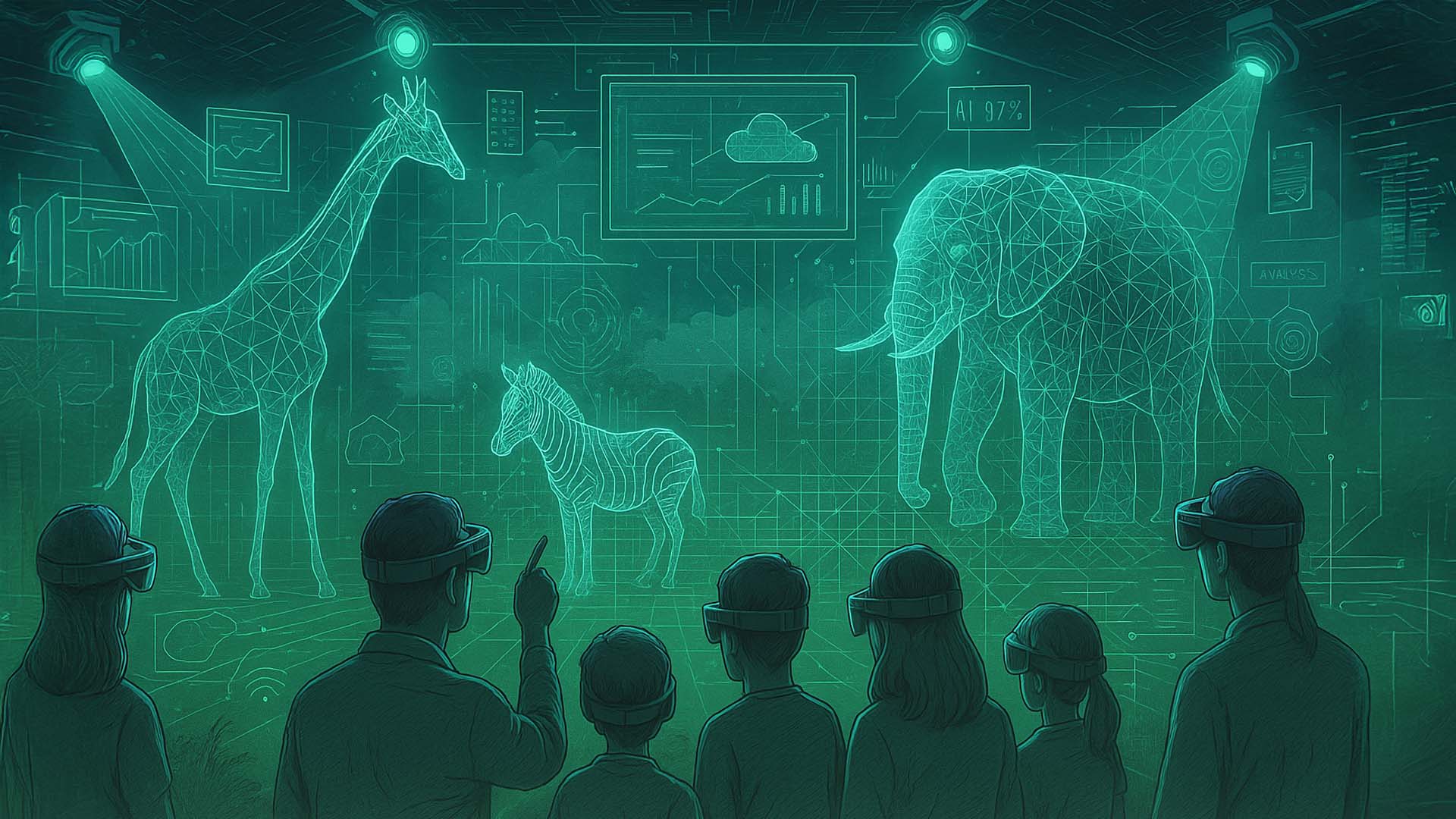
Visitors experience animals in a realistic, interactive environment.
The technology ensures that each experience remains unique—no repetition, no fixed routines.
Technical Precision for Realistic Encounters
Behind the fascination lies a precise interplay of motion data, physical spatial localization, and immersive projection technology. Animals move not only visually but also spatially accurately—they avoid obstacles, react to sounds, and adjust their position to the movements of visitors. This attention to detail ensures the experience is both believable and deeply impressive.
Technical Basis: Real-time 3D & Adaptive AI
The foundation of a holo-zoo is a combination of photogrammetric 3D scanning, motion capture, generative AI, and adaptive Mixed Reality platforms. Animals are composed from high-resolution 3D models and real motion data. AI controls how these models behave within the environmental context and in interaction with visitors.
Technological Foundation for Lifelike Wildlife Worlds
The fusion of state-of-the-art technologies makes the holo-zoo a credible and interactive alternative to the classic zoo. High-resolution 3D scans capture even the finest structures such as fur, feathers, or skin patterns, while motion capture systems authentically reproduce natural movements. Generative AI interprets this data and creates behavior that adapts seamlessly to the environment and the audience.
Dynamic Real-time Adaptation
A key feature is the adaptive control of the Mixed Reality environment. Whether it is changing light conditions, the number of visitors, or special events—the system responds in fractions of a second, altering scenarios, animal positions, and interaction possibilities accordingly. This ensures the experience is unique for every visitor.
- 3D scanning → Precise capture of shape, texture, and color details.
- Motion AI → Learning-based control of movements and reactions.
- Adaptive scenarios → Content adjusts to audience and time of day.
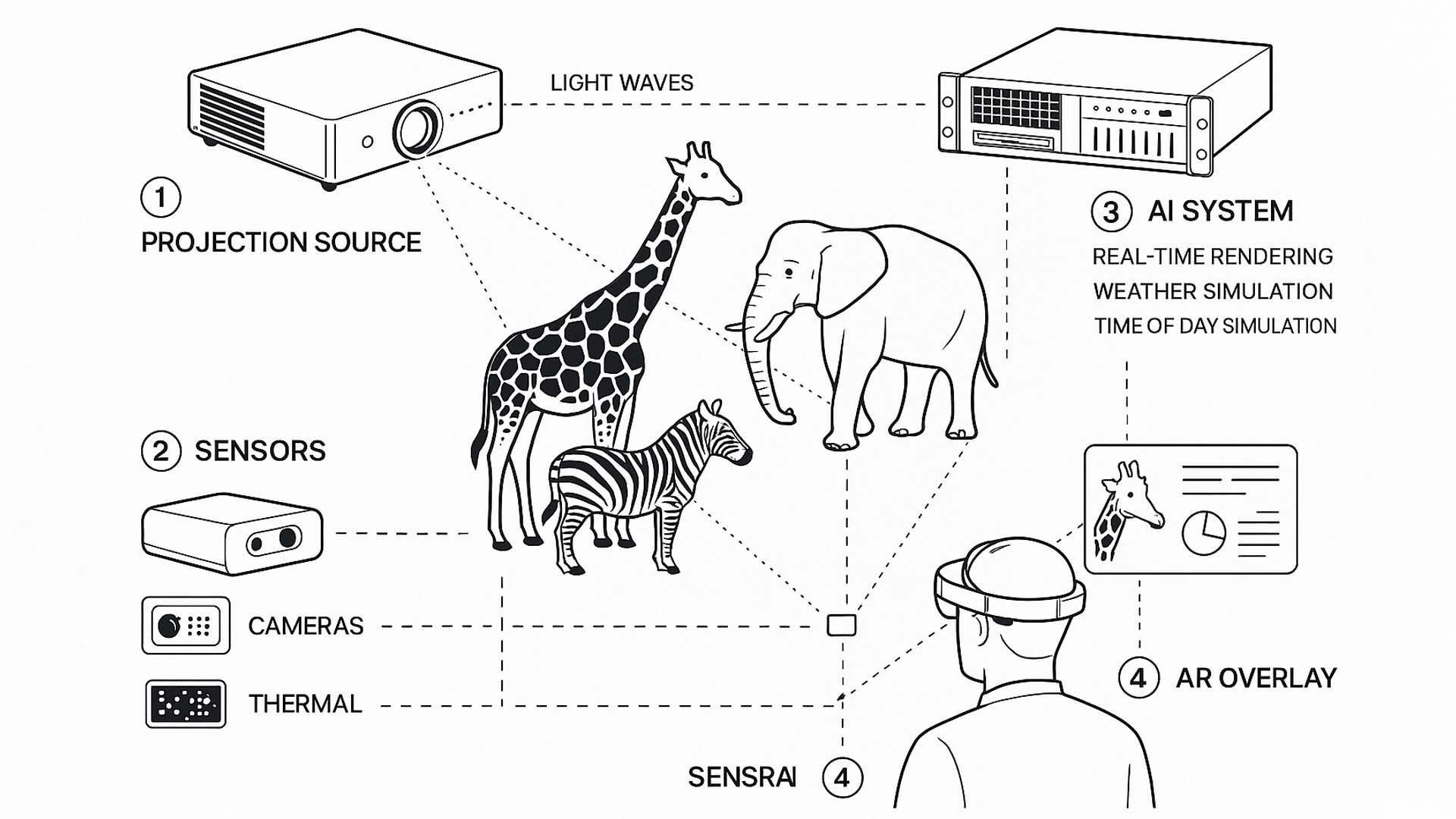
The technical framework combines AI, sensors, and Mixed Reality into a closed system.
This modular architecture allows not only animal presentations but also use in education, research, and tourism.
Continuous Expansion of the Experience Offering
Since new animal species, behavioral patterns, or entire scenarios can be added to the system at any time, the holo-zoo remains constantly up to date. Visitors can discover completely new perspectives and content on repeat visits, increasing long-term appeal.
More Than a Visual Simulation
The holo-zoo does not only use the visual dimension but also integrates spatial acoustics, subtle environmental motion, and even haptic feedback elements. This creates the impression of truly standing in a living wildlife world. The precision in form, movement, and interaction makes the boundary between physical reality and virtual representation almost disappear.
Individual Experiences for Each Visitor Group
Adaptive content generation makes it possible to tailor the holo-zoo experience precisely to the needs of the current visitors. An integrated audience analysis detects whether the visitors are children, adults, or experts, and automatically selects appropriate content, interaction elements, and narrative layers.
Dynamic Knowledge Transfer
For school groups, complex biological contexts can be taught through playful tasks, while scientific teams receive detailed data analyses and behavioral studies in real time. Families enjoy exciting stories and interactive moments that strengthen their emotional connection to wildlife.
Real-time Content: Dynamic and Personalized
A key innovation is adaptive content generation. The AI adjusts the experience in real time—whether for a school class, a family visit, or a scientific team. Each audience receives a uniquely curated sequence.
New Perspectives for Education and Business
The holo-zoo combines sustainable knowledge transfer with a future-ready business model. Thanks to its modular structure, content can be flexibly adapted and deployed worldwide—from permanent locations to temporary events.
Global Marketing and Partnerships
The platform can be licensed and distributed internationally, opening the door for collaborations with museums, zoos, universities, and conservation organizations. This creates a global network that not only shares knowledge but also drives innovation.
- Audience analysis → Systems detect who is in the space.
- Adaptive content → Knowledge level and interests shape the narrative.
- Live updates → New animal behaviors can be integrated instantly.

The AI continuously generates new content based on visitor interactions.
This makes every visit unique and ensures the technology remains relevant in the long term.
Experience Worlds as Audience Magnets
Whether as a highlight at trade shows, in theme parks, or at cultural events—holo-zoo installations create immersive moments that attract and impress visitors. The combination of education, entertainment, and technology ensures high return rates and lasting relevance.
Business Model: Sustainable Value Creation
The holo-zoo offers not only educational but also economic opportunities. Operators can generate revenue through modular content, ticket sales, educational programs, and partnerships with scientific and conservation organizations. Its modular design also facilitates international rollout.
- Licensing → Content and platforms can be marketed worldwide.
- Collaborations → Cooperation with museums, zoos, and educational institutions.
- Event integration → Temporary installations at trade fairs and festivals.
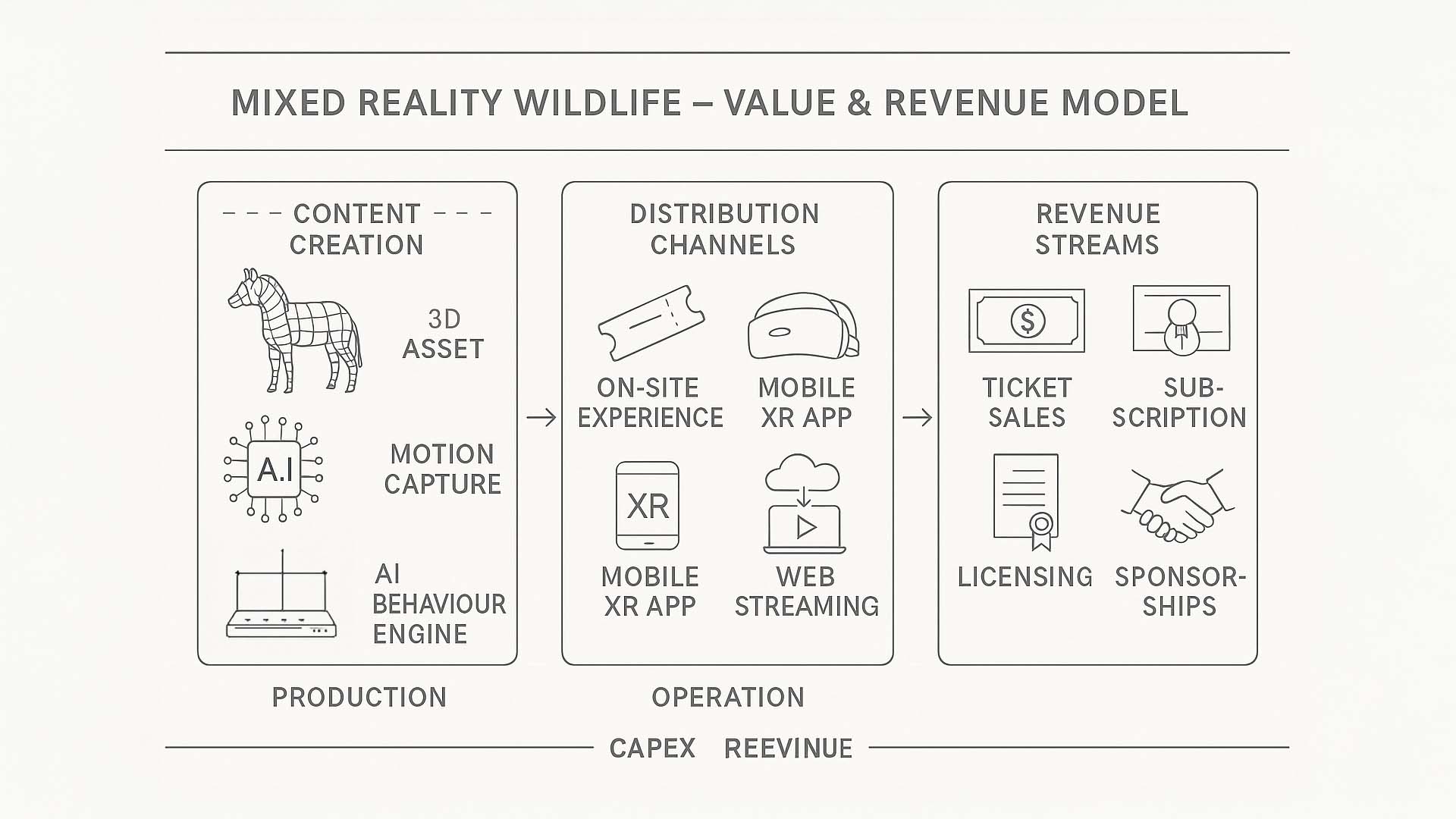
The business model is based on flexible scaling and multiple use of content.
This structure enables both local pilot projects and global brand partnerships.
Video: The Immersive Experience in Action
The video demonstrates how the holo-zoo seamlessly connects reality and virtual projection. Visitors move freely through a richly detailed Mixed Reality environment where animals appear photorealistically, respond, and interact.
The footage not only shows the impressive visual quality but also how visitors react to the animals—and vice versa. Thanks to AI-driven motion and behavior simulation, it creates an authentic sense of closeness without physically touching the animals.
A look into the live experience of a holo-zoo.
The video conveys how closely reality and virtual representation are already merging today.
Talk to Our Experts About Your Project
The holo-zoo is an invitation to technology developers, educators, conservation organizations, and investors to shape a new era of wildlife experiences together. With Mixed Reality, AI, and real-time 3D, we can reconnect education, research, and entertainment—for the benefit of both animals and people.
.
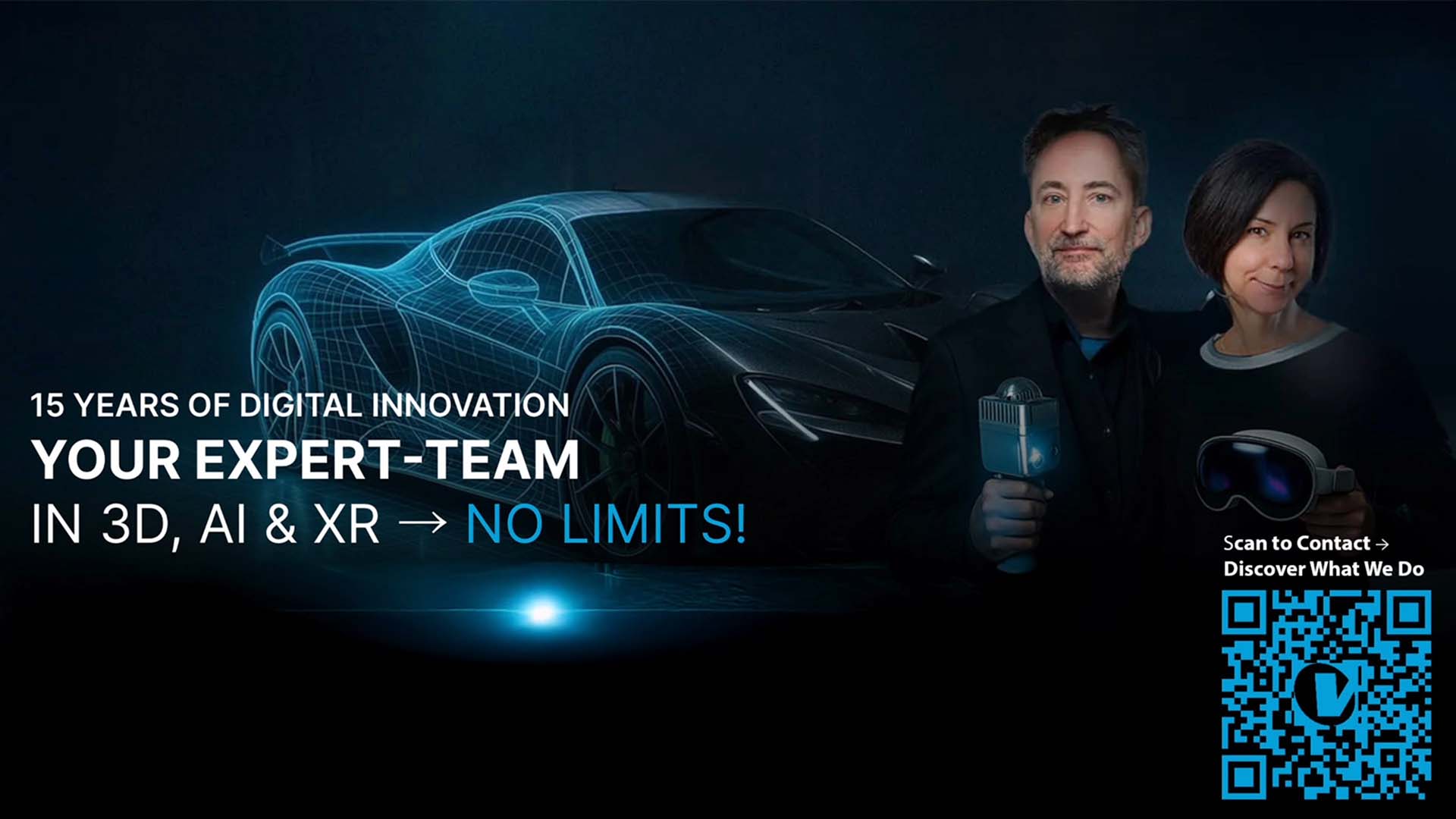
Shaping new interfaces together—with the Visoric expert team for 3D, AI, and XR.
Image source: Visoric / XR Stager
- Innovative technology → Always at the forefront of AI and Mixed Reality.
- Sustainable impact → Animal welfare at the center.
- Global reach → Scalable model for international markets.
We invite you to be part of this movement and to create immersive, ethical wildlife experiences together that promote education and awareness worldwide.
Contact Us:
Email: info@xrstager.com
Phone: +49 89 21552678
Contact Persons:
Ulrich Buckenlei (Creative Director)
Mobil +49 152 53532871
Mail: ulrich.buckenlei@xrstager.com
Nataliya Daniltseva (Projekt Manager)
Mobil + 49 176 72805705
Mail: nataliya.daniltseva@xrstager.com
Address:
VISORIC GmbH
Bayerstraße 13
D-80335 Munich


